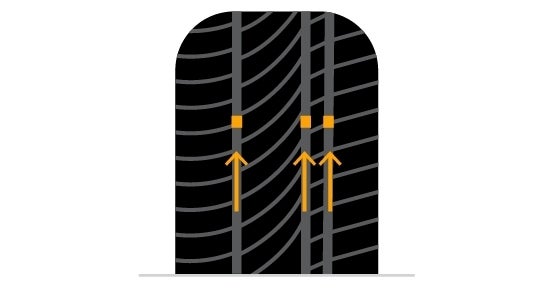
# Tyre Basics
SUV tyre legal limits
SUV tyres are versatile, but they have limits. Learn what they are here.
Depending on where you live in the world, you should be mindful of several important SUV tyre figures – not only because they’re often legal requirements, but because they will help extend the life of your tyres and also support your driving safety.
The key aspects you need to watch out for in all car tyres are age, tread depth, maximum speed and load index. Let’s take a closer look at the requirements.

What’s the right tread depth of SUV tyres?
You may already know that the legal limit for tread depth on regular road tyres is 1.6 mm. However, consider that safe driving in wet and snowy conditions is affected by the tread depth, the pattern design and the rubber compound of the tread of your tyres.

On wet or snow covered-roads braking performance will progressively decline with lower tread depths. On wet roads there is also an additional risk of aquaplaning with reduced tread depths.
Therefore, check your tyres regularly, reduce your speed on wet and snowy roads and consider replacing your tyres in good time. These figures also apply to small and medium SUVs or crossovers.
If you own an SUV with 4X4 capabilities, the limitations for tread depth are different. Some off-road tyres may begin with 20 mm of tread depth but once they get worn down, the tyre will stop working effectively and will be unsafe. As you can imagine, once the shoulders and tread of a off-road tyre get worn down, it will have far less traction on tough terrains like mud, grass and snow. Whether your SUV has 4X4 capabilities or not, you will know when it’s time to replace your tyres by its tread wear indicators (TWI). Sometimes known as wear bars, they are evenly spaced throughout the grooves of the tyre tread. If they are level with the tread, the tyre must be replaced as soon as possible.
What is the speed rating index for SUV tyres?
On the sidewall of your tyres, amongst other figures, you will see a single letter. This letter refers to your tyre’s speed rating index, or in other words, how fast it can be driven. Each letter ranging from A-Z denotes the maximum speed a tyre can sustain under its recommended load capacity.
For off-road SUVs, there’s an exception. These tyres will often have a lower speed index rating compared to on-road tyres because they often carry a lot more weight. In fact, you could expect most of our tyres for off-road usages to have a “Q” to “S” rating, which is about 99-111 mph or 160-180 km/h, while tyres suited for on-road usage have at least a “T” rating, which is about 118 mph or 190 km/h. Although they have a lower speed index, they often have a higher load index to carry the additional weight of 4X4 vehicles. And of course, while your tyre can perform at this speed, you should never exceed legal speed limits.
What is the tyre load index for SUV tyres?
While most off-road SUVs lack in speed when compared to sedans, the tyres they are typically equipped with have a much higher load index. The load index is the maximum capacity a tyre can carry. And as you might have guessed, the higher the load index number, the greater the tyre's load-carrying capacity. This is especially important when you need to tow a trailer or caravan. It is also vital to note that the load index rating represents the load-carrying capacity of tyres inflated to maximum tyre pressure; this means the load-carrying capacity will go down as tyre pressure is reduced. You can learn more about SUV tyre pressure here.
If you have a small-medium SUV that is purely used for on-road purposes, the same rule applies. You can also find the full details about your maximum tyre load index in your vehicle’s manufacturer’s manual. If you’re ever in doubt, visit your local tyre specialist.
At what age should SUV tyres be replaced?
On-road or highway tyres, including those for crossover SUVs, should be replaced at least every 10 years – including the spare. This upper age limit applies if they have been properly looked after with routine checks, have no damage and the tread meets the minimum depth requirements. We suggest replacing off-road SUV tyres at least every five years if they're used frequently in off-road conditions, or to have them checked every year once they reach the five-year mark. Off-road SUV tyres don’t last as long as regular vehicle tyres, because the tread gets worn down much faster with the weight of the vehicle and the tough terrain it crosses. You can learn more about replacing your SUV tyres here.
Related content
-
 2024/01/10Off-road drivingMost SUVs can go off paved roads to a certain degree, but for serious off-roading, you need four-wheel drive and tires that can tackle any terrain.Read more
2024/01/10Off-road drivingMost SUVs can go off paved roads to a certain degree, but for serious off-roading, you need four-wheel drive and tires that can tackle any terrain.Read more -
 2024/01/12Tyre pressure for SUV tyresTyre pressure is vital for all tyres, including SUVs, but off-road tyres are slightly different.Read more
2024/01/12Tyre pressure for SUV tyresTyre pressure is vital for all tyres, including SUVs, but off-road tyres are slightly different.Read more -
 2024/01/12Replacing SUV tyresThere are several indicators that tell you when you should replace your tires. Even if you've never had a puncture, they could be showing wearRead more
2024/01/12Replacing SUV tyresThere are several indicators that tell you when you should replace your tires. Even if you've never had a puncture, they could be showing wearRead more